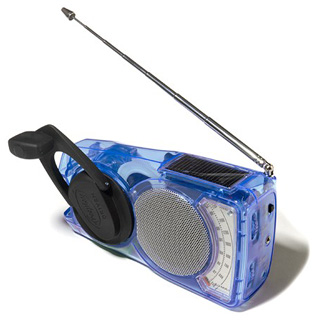 EyeMax Power
EyeMax Power
The Freeplay Alternator found in the EyeMax is a three phase axial flux unit with 12 high-strength neodymium magnets and 9 coils. Powered by hand winding, gears are used to increase the input RPM to many hundreds or 1,000+ RPM producing up to 6 Volts and theoretically 10-15 Watts of power (more like 5 Watts when turned by hand) – amazing for an alternator this small. Cogging is minimal and so hand winding feels smooth.
Just 30 seconds of moderate winding is sufficient to provide 35 minutes of radio play time, and fully charged, the radio will play for over 24 hours.
A small PV Solar Panel is fitted to the top of the radio to provide a trickle charge, and also to power the radio directly (when outside in direct sunshine).
EyeMax Battery Storage
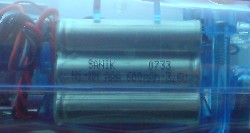
EyeMax is fitted with three rechargeable AAA NiMH batteries of 600mAh capacity (pictured above). Most people assume that a wind up radio will last forever, but sadly this is not the case. The rechargeable batteries typically used to store energy in these devices deteriorate over time and with recharging. You cannot expect the batteries to last more than 3-4 years or 2,000 recharges, particularly if you only do short (under one minute) wind up charges and don’t maintain the batteries at near to full charge.
It is therefore essential when choosing a wind up powered device to ensure that the installed rechargeable batteries can be replaced. With EyeMax this is a relatively simple task. Four screws need to be removed so the back of the radio can be separated from the main body. The batteries are fitted as a sealed battery pack with two solder tags.
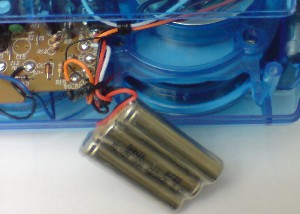
Replacement 3.6V battery packs are available commercially – typically used in cordless telephones, radio controlled toys, and walkie talkies etc – but you can also put your own together with more powerful individual AAA NiMH batteries. The latest AAA NiMH rechargeable batteries have capacities of up to 1,200mAh – double that of the EyeMax installed batteries – and therefore you can increase radio play time from 24 to 48 hours on a full charge.
A USB DC power in socket is fitted which should be used every now and then to fully charge the batteries. This will help the batteries to retain their charge storing ability for longer.
The Radio
It does not matter how efficient the charging and energy storage if the radio itself is of poor quality, but EyeMax does not disappoint. With a 0.5 Watt speaker sound quality is excellent even at full volume, and reception is excellent for both AM (500-1700kHz) and FM (88-108MHz) bands. A standard headphone socket is provided.
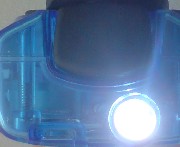
A handy ultrabright LED torch (pictured above) is also fitted into the side of EyeMax with a clever integrated on/off push button.
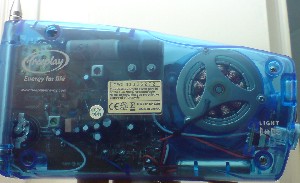
Eyemax has a transparent blue ABS plastic case which feels very robust. The whole device feels very well made and solid – weighing in at 700 grams (112mm high, 60mm thick, and 186mm wide). Being transparent all of the radio’s workings can be seen. It is possible to watch the magnets spinning at high speed around the coils of the alternator as the hand winder is used. The aerial extends to over 30cm and is also very sturdy.
Unfortunately (but not surprisingly) EyeMax is manufactured in China. However, assuming it’s internal rechargeable batteries are replaced every 3 or 4 years, there is no reason for it not to last for decades making up for its large initial carbon footprint and making it an excellent financial and environmental investment.
The only thing I would change about this EyeMax radio would be to make it easier to replace the rechargeable battery pack. At present a soldering iron (and therefore soldering experience) are required. If the batteries could instead be fitted individually into a standard battery holder, or as a commercial battery pack but with a plug-in connector (like those found in cordless telephones) the real world longevity of this device would be extended for many more people (and this product would stand out even further from its competitors.